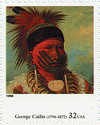
1998 32c Four Centuries of American Art: George Catlin
# 3236k - 1998 32c Four Centuries of American Art: George Catlin
$2.25 - $2.95
U.S. #3236k
32¢ George Catlin
Four Centuries of American Art
32¢ George Catlin
Four Centuries of American Art
Issue Date: August 27, 1998
City: Santa Clara, CA
Quantity: 4,000,000
Printed By: Sennett Security Products
Printing Method: Photogravure
Perforations: 10.2
Color: Multicolored
City: Santa Clara, CA
Quantity: 4,000,000
Printed By: Sennett Security Products
Printing Method: Photogravure
Perforations: 10.2
Color: Multicolored
The first painter to travel west with the sole purpose of learning more about Native Americans was George Catlin (1796-1872). Originally trained as a lawyer, Catlin became a self-taught portrait painter. Unsatisfied with either career, he decided to go out alone and attempt to capture the looks and customs of the Native American.
Catlin’s first stop on his way west was St. Louis, Missouri, where he sought the advice of General William Clark, who with Meriwether Lewis had led the first east-west expedition across America. Clark and Catlin went together to Wisconsin in 1830. By 1832, the artist was on his own. During his travels, he painted members of the Plains, Sioux, Chippewa, and Mandan tribes. The most striking images he made during his trip were of the Okeepa, the most important Mandan religious ceremony, never before witnessed by a white man. By 1840, he had visited 48 tribes.
In 1837, Catlin began displaying his gallery of Native American works, composed of nearly 500 paintings, thousands of sketches, and many artifacts. His failure to sell his paintings resulted in financial ruin, and Catlin was imprisoned for debt in 1852 in London. He eventually sold his entire collection, and later became an advisor to the Smithsonian Institution.
U.S. #3236k
32¢ George Catlin
Four Centuries of American Art
32¢ George Catlin
Four Centuries of American Art
Issue Date: August 27, 1998
City: Santa Clara, CA
Quantity: 4,000,000
Printed By: Sennett Security Products
Printing Method: Photogravure
Perforations: 10.2
Color: Multicolored
City: Santa Clara, CA
Quantity: 4,000,000
Printed By: Sennett Security Products
Printing Method: Photogravure
Perforations: 10.2
Color: Multicolored
The first painter to travel west with the sole purpose of learning more about Native Americans was George Catlin (1796-1872). Originally trained as a lawyer, Catlin became a self-taught portrait painter. Unsatisfied with either career, he decided to go out alone and attempt to capture the looks and customs of the Native American.
Catlin’s first stop on his way west was St. Louis, Missouri, where he sought the advice of General William Clark, who with Meriwether Lewis had led the first east-west expedition across America. Clark and Catlin went together to Wisconsin in 1830. By 1832, the artist was on his own. During his travels, he painted members of the Plains, Sioux, Chippewa, and Mandan tribes. The most striking images he made during his trip were of the Okeepa, the most important Mandan religious ceremony, never before witnessed by a white man. By 1840, he had visited 48 tribes.
In 1837, Catlin began displaying his gallery of Native American works, composed of nearly 500 paintings, thousands of sketches, and many artifacts. His failure to sell his paintings resulted in financial ruin, and Catlin was imprisoned for debt in 1852 in London. He eventually sold his entire collection, and later became an advisor to the Smithsonian Institution.









